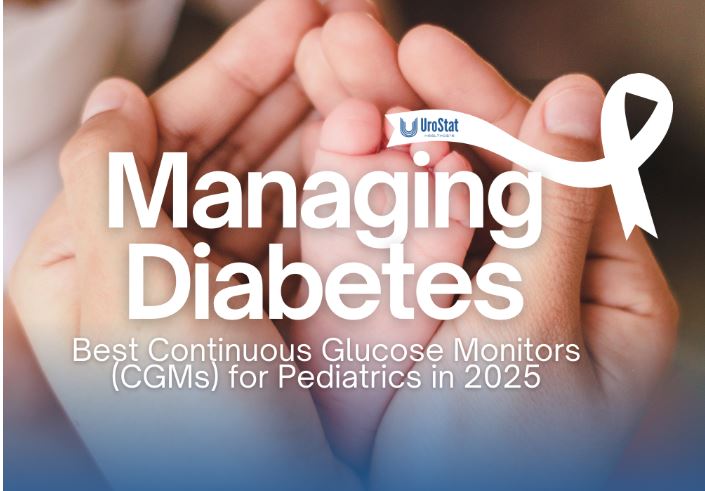
Managing diabetes in children is challenging. Parents constantly worry about their child’s blood sugar levels, especially at school, playing, or sleeping.
Continuous Glucose Monitors (CGMs) offer a reliable solution by providing real-time glucose tracking without the need for constant finger pricks. These smart devices help parents monitor blood sugar trends, reduce emergencies, and improve overall diabetes care.
Unlike traditional glucose meters, CGMs work 24/7, alerting parents and caregivers to high or low blood sugar levels. With advanced sensors and wireless connectivity, these devices provide a pain-free and efficient way to manage pediatric diabetes.
Why Are CGMs Essential for Children with Diabetes?
Children with diabetes need consistent monitoring to prevent dangerous fluctuations in blood sugar.
Fingerstick tests, while effective, can be painful and inconvenient. CGMs eliminate this struggle by offering:
- Real-time Glucose Tracking: Parents receive instant updates on their child’s blood sugar levels.
- Fewer Finger Pricks: Sensors continuously measure glucose levels, reducing the need for manual testing.
- Early Alerts and Alarms: CGMs warn about dangerous highs and lows before symptoms appear.
- Data-sharing Capabilities: Parents and doctors can monitor glucose trends remotely using smartphone apps.
With these benefits, CGMs empower children to live more freely while giving parents peace of mind.
What Are Continuous Glucose Monitors (CGMs)?
Continuous Glucose Monitors (CGMs) are wearable devices that help track blood sugar levels without finger pricks
CGMs Track Blood Sugar Levels in Real Time
These devices provide real-time glucose readings, allowing parents and caregivers to monitor a child’s blood sugar throughout the day and night.
Unlike traditional blood sugar testing, which requires fingerstick checks multiple times a day, CGMs work continuously. They measure glucose levels every few minutes, sending instant updates to a receiver or smartphone app.
How Do Continuous Glucose Monitors (CGMs) Work?
CGMs use a tiny sensor inserted under the skin to measure glucose levels in interstitial fluid (the fluid between cells).
This sensor sends data to a transmitter, which then communicates with a receiver or mobile app.
How CGMs Function Step by Step:
- Sensor: A small sensor is placed under the skin (usually on the arm or abdomen).
- Transmitter: The sensor sends glucose readings to a transmitter.
- Receiver/App: The transmitter sends real-time data to a receiver, smartphone, or smartwatch.
- Alerts & Trends: CGMs provide alerts for high and low blood sugar levels, helping to prevent emergencies.
CGMs vs. Traditional Fingerstick Testing
| Feature | Continuous Glucose Monitors (CGMs) | Traditional Fingerstick Testing |
| Monitoring Frequency | Every 5-15 minutes, 24/7 | Only when tested manually |
| Pain Level | Minimal (small sensor) | Can be painful (multiple pricks daily) |
| Alerts & Warnings | Sends real-time alerts for highs/lows | No automatic alerts |
| Data Tracking | Continuous glucose trends | Only single-point readings |
| Ease of Use | Automatic, no frequent pricking needed | Requires manual testing |
| Best For | Children, active lifestyles, better diabetes control | Quick spot-checks when needed |
CGMs provide a more detailed view of blood sugar patterns, making it easier to adjust meals, insulin doses, and activity levels.
Key Components of a CGM System
1️⃣ Sensor
- A tiny device placed under the skin to measure glucose in interstitial fluid.
- Stays in place for 7-14 days, depending on the model.
2️⃣ Transmitter
- Sends glucose readings from the sensor to a receiver or smartphone.
- Some CGMs have built-in Bluetooth for wireless data transfer.
3️⃣ Receiver or Mobile App
- Displays real-time glucose readings, trends, and alerts.
- Parents can track glucose remotely using a smartphone or smartwatch.
Why Are CGMs Important for Pediatrics?
CGMs Help Track a Child’s Blood Sugar Levels 24/7.
Managing diabetes in children requires constant monitoring. Continuous Glucose Monitors (CGMs) provide real-time blood sugar tracking, reducing the stress of frequent fingerstick tests. Parents and doctors can access glucose readings anytime, ensuring better diabetes control.
Traditional monitoring relies on manual testing, which may miss sudden spikes or drops in blood sugar. CGMs work around the clock, sending automatic alerts when glucose levels are too high or low. This helps prevent dangerous situations, keeping children safe at school, during activities, and even while sleeping.
Benefits of CGMs for Children with Diabetes
1️⃣ Fewer Finger Pricks, Less Pain
- Traditional testing requires multiple daily fingersticks, which can be painful and stressful.
- CGMs use a tiny sensor under the skin, eliminating the need for frequent pricking.
- This makes diabetes management less intrusive and more comfortable for children.
2️⃣ Better Diabetes Control
- CGMs track blood sugar every 5-15 minutes, providing a detailed view of glucose trends.
- Parents and doctors can adjust insulin, diet, and activity levels based on real-time data.
- This reduces the risk of dangerous highs and lows, improving overall health.
3️⃣ Real-Time Alerts for Immediate Action
- CGMs send alerts when blood sugar levels are rising or dropping too fast.
- Parents receive notifications on their phone, allowing them to respond immediately.
- This helps prevent severe hypoglycemia (low blood sugar) or hyperglycemia (high blood sugar).
How CGMs Prevent Dangerous Highs and Lows?
Without CGMs, blood sugar changes may go unnoticed until symptoms appear. This can be dangerous for young children, who may not recognize warning signs of a glucose emergency.
CGMs provide:
- Early warning alerts before glucose levels reach dangerous levels.
- Trend tracking, showing whether blood sugar is rising or falling.
- Remote monitoring, so parents and caregivers can check readings even when the child is away.
With these features, CGMs allow for quick action, preventing hospital visits and serious complications.
Top Continuous Glucose Monitors (CGMs) for Pediatrics in 2025
The Best CGM Products for Children in 2025
Parents need accurate, reliable, and comfortable CGMs to monitor their child’s diabetes effectively. The best pediatric CGMs offer:
✔ High accuracy for precise glucose tracking.
✔ Comfortable sensors that stay in place during play and sleep.
✔ Real-time alerts to warn of blood sugar changes.
✔ Easy-to-use apps for remote monitoring by parents and doctors.
Below, we compare the top CGMs for pediatrics in 2025, focusing on accuracy, comfort, and usability.
| CGM Model | Key Features | Best For | Sensor Life |
| ✅ Dexcom G7 | – Real-time tracking with high accuracy. | Kids needing instant alerts. | 10 days |
| – Works with smartphones & smartwatches. | Parents who prefer mobile tracking. | ||
| ✅ FreeStyle Libre 3 | – Painless scan-based monitoring. | Active kids who dislike finger pricks. | 14 days |
| – Affordable CGM supplies. | Families looking for budget-friendly CGMs. | ||
| ✅ Medtronic Guardian | – Predictive alerts prevent glucose swings. | Kids using insulin pumps. | 7 days |
| – Compatible with Medtronic insulin pumps. | Parents needing automated insulin adjustments. |
Accuracy Comparison: CGM Performance Over Time
Here’s how these CGMs compare in terms of accuracy and stability over two weeks:
Glucose Accuracy Over Time (%)
(Ideal accuracy is above 90%)
CGM Accuracy Trends Over 14 Days
The graph above shows how the accuracy of different pediatric CGMs changes over 14 days. The Dexcom G7 maintains the highest accuracy, while the FreeStyle Libre 3 and Medtronic Guardian gradually decrease in performance over time.
Which CGM Is Best for Your Child?
1️⃣ Dexcom G7 – Best for Real-Time Alerts
✅ Why Choose It?
✔ Most accurate CGM with instant glucose updates.
✔ Seamless integration with smartphones & smartwatches.
✔ Ideal for active kids who need constant monitoring.
2️⃣ FreeStyle Libre 3 – Best for Painless Monitoring
✅ Why Choose It?
✔ No painful finger pricks – just scan to check glucose.
✔ Affordable CGM supplies with a long 14-day sensor life.
✔ Best for budget-conscious families needing reliable tracking.
3️⃣ Medtronic Guardian Connect – Best for Pump Users
✅ Why Choose It?
✔ Predictive alerts prevent blood sugar swings.
✔ Pairs with Medtronic insulin pumps for automated adjustments.
✔ Best for children needing advanced diabetes control.
How to Choose and Integrate the Best CGM for Your Child
Selecting the right Continuous Glucose Monitor (CGM) is a big decision for parents managing pediatric diabetes. The best CGM should fit your child’s lifestyle, provide accurate readings, and be easy to use. Once chosen, the next challenge is seamlessly integrating CGMs into your child’s daily routine—from school to sports to sleep.
Step 1: Choosing the Best CGM for Your Child
✅ Accuracy & Reliability Come First
A CGM’s primary role is to provide precise glucose tracking. Choose a model with high accuracy, especially during rapid glucose fluctuations (common in children).
🔹 Dexcom G7 – Best for instant alerts and precise tracking.
🔹 FreeStyle Libre 3 – Reliable, but readings require scanning.
🔹 Medtronic Guardian – Great for insulin pump users.
✅ Consider Your Child’s Age & Lifestyle
Younger children need small, flexible, and comfortable CGMs. Teens may prefer smartphone-connected models with discreet tracking options.
Best for Toddlers & Young Kids: FreeStyle Libre 3 (painless scanning).
Best for Active Kids & Teens: Dexcom G7 (real-time alerts & waterproof sensors).
✅ Sensor Size & Ease of Application
Children with active lifestyles need lightweight sensors that stay in place. Some CGMs require manual insertion, while others automatically apply themselves.
✔ Smaller Sensors = More comfort (FreeStyle Libre 3).
✔ Auto-Insertion = Less pain (Dexcom G7).
✅ Smartphone Compatibility & Remote Monitoring
Most CGMs allow remote tracking via mobile apps, making it easier for parents to monitor readings from anywhere.
Dexcom G7 & FreeStyle Libre 3 sync with smartphones.
Medtronic Guardian connects with insulin pumps & mobile apps.
✅ Cost & Insurance Coverage
CGMs can be expensive, but many are covered by insurance plans. Some brands offer home-delivered CGM supplies, making diabetes management more convenient and affordable.
Step 2: Integrating CGMs into Your Child’s Daily Life
A CGM is only useful if it fits smoothly into your child’s routine. Here’s how to make it feel natural and stress-free.
At School: CGM Management for Teachers & Nurses
- Inform school staff about the CGM and how to read alerts.
- Set discreet alarms to avoid classroom disruptions.
- Pack extra CGM supplies in your child’s backpack.
- Use a data-sharing app so parents can monitor remotely.
During Sports & Outdoor Play: Keeping the CGM Secure
- Choose waterproof CGMs for swimming or intense sports.
- Use CGM patches or bands to keep sensors in place.
- Educate coaches about hypoglycemia symptoms and CGM alerts.
At Night: Ensuring Safe Sleep with CGMs
- Enable nighttime alarms for glucose fluctuations.
- Place the receiver close to your bed for immediate alerts.
- Keep low-sugar snacks nearby for quick corrections.
- Use a smartwatch for silent vibration alerts instead of loud alarms.
Insurance Coverage & Home-Delivered CGM Supplies
Making CGMs More Accessible for Parents
Managing a child’s diabetes can be overwhelming, especially when dealing with CGM costs and supply shortages. The good news is most insurance plans cover CGMs, and home-delivered CGM supplies eliminate the hassle of pharmacy visits.
Here’s how parents can navigate insurance coverage and secure home-delivery services for a stress-free diabetes management experience.
✅ Does Insurance Cover CGMs for Children?
Most private insurance providers, Medicaid, and Medicare offer full or partial coverage for CGMs. However, policies vary based on:
- Child’s age and medical condition (some plans require proof of Type 1 diabetes).
- Doctor’s prescription (a letter of medical necessity may be needed).
- CGM brand preference (some insurance companies cover specific models only).
How to Check Your Insurance Coverage?
🔹 Step 1: Call your insurance provider and ask about CGM eligibility for pediatrics.
🔹 Step 2: Request a list of approved CGM products under your plan.
🔹 Step 3: Ask if CGM supplies are covered for home delivery.
🔹 Step 4: Verify your copay, deductibles, and out-of-pocket costs.
Pro Tip: Many CGM suppliers offer insurance verification services to handle the paperwork for you!
Benefits of Home-Delivered CGM Supplies
Parents already juggle doctor appointments, school, and daily routines. Home-delivered CGM supplies offer a convenient solution by ensuring regular sensor replacements without pharmacy trips.
Why Choose Home Delivery?
✔ No Missed Refills – supplies arrive before sensors expire.
✔ Less Stress – no need to visit multiple pharmacies.
✔ Fast & Secure Shipping – supplies delivered straight to your doorstep.
Common Concerns About CGMs for Pediatrics
❓ Are CGMs Safe for Young Children?
✅ Yes! Most CGMs are FDA-approved for kids as young as 2 years old.
✔ Non-invasive & Painless – uses a tiny sensor, not a needle.
✔ Safe Materials – designed for long-term wear without irritation.
Talk to your child’s doctor to find the best CGM for their skin type & activity level.
❓ Can a CGM Replace Fingerstick Testing Completely?
⚠ Mostly, but occasional checks may still be needed.
✔ CGMs provide continuous readings, but fingerstick tests may be required for:
- Sensor calibration (some models need manual verification).
- Double-checking unusual readings before insulin dosing.
- During sensor malfunctions or signal loss.
Use fingersticks sparingly and rely on CGMs for day-to-day monitoring.
❓ Are CGMs Painful for Kids?
✅ No! CGMs are designed for comfort with minimal pain.
✔ Sensors use microsized filaments, making insertion quick and barely noticeable.
✔ Many CGMs offer auto-insertion to reduce discomfort.
✔ Some brands have smaller sensors for better flexibility.
If your child is nervous, let them hold & explore the CGM before applying it!
Future of Pediatric CGMs in 2025 and Beyond
Technology is revolutionizing Continuous Glucose Monitors (CGMs), making them smarter, smaller, and more accurate. In 2025 and beyond, CGMs for pediatrics will focus on non-invasive monitoring, AI-powered predictions, and increased affordability.
Here’s what to expect in the future of CGMs for children with diabetes.
1️⃣ Non-Invasive CGMs – No Needles, No Pain
Traditional CGMs use a tiny sensor inserted under the skin. While minimally invasive, some children still find sensor application uncomfortable. New non-invasive CGMs aim to eliminate needles.
What’s Coming?
✔ Needle-free CGMs using optical sensors to measure glucose through the skin.
✔ Wearable patches that check blood sugar levels via sweat or interstitial fluid.
✔ Laser-based CGMs to track glucose without skin penetration.
Impact: This technology will increase CGM adoption among younger children who fear needles.
2️⃣ AI-Powered CGMs – Smarter & More Predictive
Artificial Intelligence (AI) is transforming diabetes management. AI-powered CGMs will not only track glucose but predict future trends.
How AI Will Improve CGMs?
✔ Predicting blood sugar spikes before they happen.
✔ Learning daily patterns to suggest insulin adjustments.
✔ Sending proactive alerts to prevent highs/lows in advance.
Impact: AI-powered CGMs will help children, parents, and doctors make faster, smarter treatment decisions.
3️⃣ More Insurance Coverage & Affordability Improvements
CGMs are lifesaving but expensive. Many families struggle to afford them, even with insurance.
In 2025, expect:
✔ Expanded insurance coverage for pediatric CGMs.
✔ More government funding & reimbursement programs.
✔ Cheaper CGM options with home-delivered CGM supplies.
Impact: Greater accessibility will allow more children to benefit from CGMs, reducing hospital visits and diabetes-related complications.
FAQs
How much does a CGM cost?
CGMs cost $100 to $300 per month, depending on the brand and insurance coverage.
What are the negatives of CGM?
Some CGMs require sensor replacements, occasional calibrations, and may cause skin irritation in sensitive users.
Can I buy a CGM over the counter?
No, most CGMs require a doctor’s prescription, but some models may be available in pharmacies.
What are CGM products?
CGM products include sensors, transmitters, receivers, and mobile apps for continuous glucose monitoring.
What is the best CGM for kids?
The Dexcom G7 and FreeStyle Libre 3 are top choices due to accuracy, comfort, and ease of use.
Do CGMs replace fingerstick testing?
Mostly, but some CGMs still require occasional fingersticks for calibration or verification.
At what age can a child start using a CGM?
Many CGMs are FDA-approved for children as young as 2 years old.
Can CGMs be worn while swimming?
Yes, most CGMs are water-resistant, but exposure time and depth vary by brand.
How long do CGM sensors last?
Sensor life ranges from 7 to 14 days, depending on the model.
Can CGMs help with non-diabetic glucose monitoring?
Yes, some people use CGMs for tracking glucose trends related to diet, exercise, and metabolic health.
Trusted Providers for CGM Products & Home Delivery
UroStat Healthcare – Your Go-To for Home-Delivered CGM Supplies
UroStat Healthcare specializes in providing continuous glucose monitoring system (CGM) supplies with home delivery services. Their goal is to make diabetes mellitus management easier for families by ensuring a hassle-free supply chain for CGM products.
With accurate glucose data, parents can make better diabetes treatment decisions and prevent high blood glucose or low blood glucose episodes.
Why Choose UroStat Healthcare?
✔ Fast & Reliable Delivery – Get CGM sensors, transmitters, and accessories shipped directly to your home.
✔ Insurance Assistance – Helps verify insurance coverage and handle paperwork for eligible CGM users.
✔ Automated Refill Options – Prevents supply shortages by ensuring timely sensor replacements.
✔ Customer Support – Provides expert guidance on choosing the right continuous glucose monitoring device for pediatric patients.
✔ Trusted CGM Provider – Works with top brands recognized by the American Diabetes Association for accurate blood glucose level tracking.
Take Control of Your Child’s Diabetes with UroStat Healthcare!
Shop CGM products, verify insurance, and set up home delivery today!



